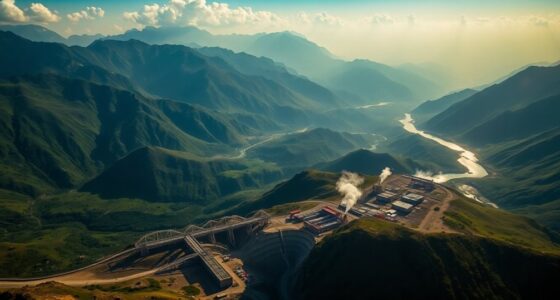Carbon Capture and Storage (CCS) can really work to reduce industrial CO₂ emissions if implemented properly. It captures carbon from sources, transports it, and stores it underground safely. While it’s promising, concerns about leaks, environmental risks, and high costs remain. Its success depends on effective management, supportive policies, and proper infrastructure. Curious about how these factors play out and the real potential of CCS? Keep exploring to understand whether it’s a viable climate solution.
Key Takeaways
- CCS effectively reduces CO2 emissions when properly implemented, but its success depends on infrastructure, safety, and management.
- It involves capturing CO2 from industrial sources, transporting it, and securely storing it underground.
- Environmental risks include potential leaks and induced seismic activity, which require careful monitoring and risk mitigation.
- The economic viability of CCS varies; high costs and policy support influence its widespread adoption.
- Overall, CCS can work as part of climate strategies, but its effectiveness relies on technological, environmental, and economic factors.

Carbon Capture & Storage (CCS) is a technology that helps reduce carbon dioxide emissions from industrial processes and power plants. You might wonder if investing in CCS makes sense, especially when considering its cost effectiveness and potential environmental risks. The truth is, CCS can be a valuable tool in lowering greenhouse gases, but it’s not without its challenges. One of the key factors you should consider is whether the technology is cost effective for your specific needs. Implementing CCS requires significant upfront investment in capturing equipment, transportation infrastructure, and underground storage sites. While some projects have shown promising results in reducing emissions at a manageable cost, others remain expensive, and the long-term financial benefits can vary. The economic viability often depends on factors like carbon pricing, government subsidies, and the scale of deployment. If these elements are favorable, CCS can become more cost effective, making it a more appealing option for industries looking to meet climate targets without overhauling their entire operations.
However, you should also weigh the environmental risks associated with CCS. Although the technology aims to trap CO2 underground, there’s always a concern about potential leaks from storage sites, which could undermine its climate benefits. These risks include natural earthquakes, well integrity issues, or unforeseen geological movements that might allow stored CO2 to escape into the atmosphere. Such leaks could negate the emissions reductions achieved by capturing the CO2 in the first place. Additionally, the process of capturing, compressing, and transporting CO2 requires energy, which can lead to increased emissions elsewhere—sometimes referred to as the “energy penalty.” This means that, in some cases, CCS might not be entirely carbon neutral, and you need to consider whether the environmental trade-offs are justified.
Furthermore, the environmental risks extend beyond just leaks. The large-scale infrastructure needed for CCS can disrupt ecosystems and pose safety concerns for nearby communities if not managed properly. While ongoing research aims to minimize these risks, they are important factors to evaluate before adopting CCS at a broad scale. To sum up, CCS offers a promising route to reduce industrial emissions, but its cost effectiveness depends heavily on economic conditions and policies, and the environmental risks require careful assessment and management. If you’re considering CCS as part of your emission reduction strategy, make certain that you weigh these factors carefully to determine whether it’s a viable and responsible option for your goals.
Frequently Asked Questions
What Are the Long-Term Environmental Impacts of CCS?
You might wonder about CCS’s long-term environmental impacts. While it aims to reduce greenhouse gases, it can cause ecosystem disruption if underground storage sites leak or aren’t secure. Chemical contamination from potential leaks or faulty infrastructure might threaten soil and water quality. You should consider that, although CCS offers benefits, ongoing monitoring and risk management are essential to minimize these environmental risks over time.
How Much Does CCS Technology Cost to Implement Globally?
You should consider that the cost analysis of CCS technology varies widely, depending on factors like plant size and location. Implementing CCS globally requires significant investment, making some projects less financially feasible without subsidies or policy support. Overall, the financial feasibility of CCS remains uncertain, as high costs can hinder widespread adoption. To evaluate its viability, you’d need to weigh the long-term environmental benefits against these hefty upfront expenses.
Can CCS Be Applied to Existing Power Plants?
You’re asking if CCS can be applied to existing power plants. It’s not a walk in the park, as retrofit challenges can be significant. You might face issues maintaining operational efficiency while installing capture systems. Upgrading older plants requires careful planning to avoid disrupting power output. While feasible, it’s often a balancing act—making sure the benefits outweigh the costs and complexities involved in retrofitting.
What Are the Risks of Co₂ Leakage From Storage Sites?
You should consider that CO₂ leakage risks depend on geological stability and monitoring challenges at storage sites. If the geology isn’t stable, leaks can occur through faults or fractures. Monitoring challenges make it hard to detect leaks early, increasing environmental risks. Proper site selection, thorough geological assessments, and advanced monitoring technologies help minimize these risks, ensuring that CO₂ stays securely stored and reducing potential harm to the environment.
How Does CCS Compare to Renewable Energy in Reducing Emissions?
Imagine choosing between planting a single tree or building a vast forest. CCS acts like a seed that needs nurturing, but it faces scalability challenges and higher costs compared to renewables. While renewables like wind and solar are more affordable and easier to expand, CCS might work for specific industries. Ultimately, renewables offer a more reliable, cost-effective path to emission reduction, but CCS could be a complementary tool.
Conclusion
So, while Carbon Capture & Storage might seem like a silver bullet for saving the planet, don’t buy into the hype blindly. It’s a promising tool, but it’s not a magic fix that will instantly solve climate change. Think of it as a vital piece of a massive puzzle—you still need renewable energy and lifestyle changes. Relying solely on CCS is like putting all your hope in a single star—hopeful, but not enough to light up the entire sky.










